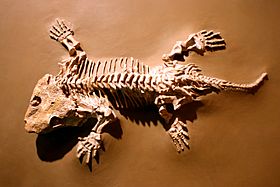Seymouria facts for kids
Seymouria was an amphibian animal that lived a very long time ago. It was a tetrapod, meaning it had four limbs. Seymouria lived during the early Permian period, about 280 to 270 million years ago. Its fossils have been found in North America and Europe. This animal was quite small, only about 2 feet (60 cm) long.
Quick facts for kids SeymouriaTemporal range: early Permian 280–270 mya
|
|
|---|---|
 |
|
| Seymouria baylorensis from the early Permian of North America, Museum of Natural History, Washington | |
| Scientific classification | |
| Kingdom: | |
| Phylum: | |
| Class: | |
| Order: |
Seymouriamorpha
|
| Genus: |
Seymouria
|
As an adult, Seymouria was very well adapted to living on land. It had many features that looked like those of reptiles. For a long time, scientists even thought it was an early reptile! However, we now know that Seymouria was an amphibian. This means its early life stages happened in water. Its adult body was just very good at living in dry places.
Land or Water?
Finding out that Seymouria was an amphibian was a big surprise. Scientists discovered that its young stages, called larvae, lived in water. This proved that Seymouria was not a reptile. Larval fossils have been found for similar animals in Europe.
These discoveries showed clearly that Seymouria had a life history like an amphibian. Its young lived in water and had gills. After they grew up, they lost their gills during a process called metamorphosis. This is just like how a tadpole changes into a frog. So, Seymouria was definitely not a reptile.
Where Did Seymouria Live?
The first adult Seymouria skeletons were found in special rock layers in Texas and Oklahoma. These rocks are called "red beds." They formed in a huge delta area, like where a big river meets the sea. Think of the Mississippi River today; it forms a similar delta.
Another species, Seymouria sanjuanensis, was found in Germany and New Mexico. This type of Seymouria had very strong legs. It could hold its body high off the ground. This shows it was very good at moving around on land.
Seymouria's Life Cycle
Here is a simple way to think about Seymouria's life cycle:
- Eggs were laid in water.
- Young larvae lived in the water.
- When they grew limbs, the young animals climbed out of the water.
- They then moved to higher, drier ground.
- As adults, they lived on dry land and ate other animals.
- They would go back to the water sometimes to drink and to lay their own eggs.
Adult Seymouria could live well in places that were quite dry.
Images for kids
-
A copy of a rock block from the Cutler Formation with six Seymouria sanjuanensis skeletons.
See also
 In Spanish: Seymouria para niños
In Spanish: Seymouria para niños





